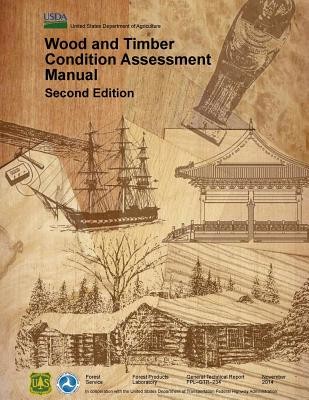
- We will send in 10–14 business days.
- Author: U S Department of Agriculture
- Publisher: CreateSpace Independent Publishing Platform
- ISBN-10: 1974398218
- ISBN-13: 9781974398218
- Format: 21.6 x 27.9 x 0.7 cm, minkšti viršeliai
- Language: English
- SAVE -10% with code: EXTRA
Wood and timber condition assessment manual (e-book) (used book) | bookbook.eu
Reviews
Description
Deterioration of an in-service wood member may result from a variety of causes during the life of a structure. Periodic inspection of wood used in structures is important for determining the extent of deterioration so that degraded members may be replaced or repaired to avoid structural failure. Inspection professionals use a wide variety of techniques to assess the condition of wood in service. Visual, mechanical probing, and stress wave or ultrasound-based techniques are all used either individually or in combination by inspectors. Although these techniques are based on solid technical information and supporting research, prior to publication of the Wood and Timber Condition Assessment Manual in 2004, no practical, comprehensive manual provided information on inspection of wood in service. The Wood and Condition Assessment Manual was prepared to address this need. The manual was prepared from numerous research studies, inspections, and lectures dealing with assessing the condition of in-service wood and timber. It was intended for inspection professionals. A concerted effort was made to provide clear and concise explanations of various aspects of inspecting in-service wood and timber. To this end, a number of photographs and drawings obtained from actual inspections were included. The 2004 Wood and Timber Condition Assessment Manual proved to be a widely used reference document and a primary technical source for inspection professionals worldwide. User feedback included many positive comments about description of the various inspection tools available and post-fire assessment of structural wood members. Users did express a strong desire to have information on the estimation of allowable design values for in-service wood in future editions.
EXTRA 10 % discount with code: EXTRA
The promotion ends in 21d.22:44:30
The discount code is valid when purchasing from 10 €. Discounts do not stack.
- Author: U S Department of Agriculture
- Publisher: CreateSpace Independent Publishing Platform
- ISBN-10: 1974398218
- ISBN-13: 9781974398218
- Format: 21.6 x 27.9 x 0.7 cm, minkšti viršeliai
- Language: English English
Deterioration of an in-service wood member may result from a variety of causes during the life of a structure. Periodic inspection of wood used in structures is important for determining the extent of deterioration so that degraded members may be replaced or repaired to avoid structural failure. Inspection professionals use a wide variety of techniques to assess the condition of wood in service. Visual, mechanical probing, and stress wave or ultrasound-based techniques are all used either individually or in combination by inspectors. Although these techniques are based on solid technical information and supporting research, prior to publication of the Wood and Timber Condition Assessment Manual in 2004, no practical, comprehensive manual provided information on inspection of wood in service. The Wood and Condition Assessment Manual was prepared to address this need. The manual was prepared from numerous research studies, inspections, and lectures dealing with assessing the condition of in-service wood and timber. It was intended for inspection professionals. A concerted effort was made to provide clear and concise explanations of various aspects of inspecting in-service wood and timber. To this end, a number of photographs and drawings obtained from actual inspections were included. The 2004 Wood and Timber Condition Assessment Manual proved to be a widely used reference document and a primary technical source for inspection professionals worldwide. User feedback included many positive comments about description of the various inspection tools available and post-fire assessment of structural wood members. Users did express a strong desire to have information on the estimation of allowable design values for in-service wood in future editions.


Reviews